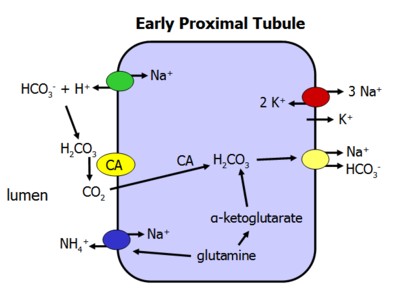
- cells and molecules home
- carbohydrates
- proteins
- fats
- vitamins
- minerals
- electrolytes
- water
- nucleic acids
- gases
Section Links
Bicarbonate
- what is bicarbonate?
- where does bicarbonate come from?
- bicarbonate needs
- bicarbonate absorption
- bicarbonate regulation
- bicarbonate and the kidney
- bicarbonate functions in the body
What is Bicarbonate?
Where does Bicarbonate Come from?
Bicarbonate Needs
Bicarbonate Absorption
Bicarbonate Regulation

The physiologic concentration of HCO3 is 24 mmol/l, while the concentration of H+ is 40 nmol/l.
Bicarbonate Reabsorption in the Kidney
The kidney has the capacity to regulate blood pH by addition or secretion of bicarbonate.
Normally, all HCO3 is reabsorbed, giving urine a pH of less than 7. Vegans have a more alkaline diet, and so some HCO3 is excreted in the urine. Addition of large amounts of HCO3- to the blood will be dealt with rapidly by the kidney through excretion.
Loss of bicarbonate produces renal tubular acidosis.
Seventy percent of HCO3 reabsorption occurs in the proximal tubule, with the rest in the LoH.
In the proximal tubule,
- HCO3 reabsorption is coupled with H+ secretion the Na/H antiporter.
- CA works both in the lumenal brush border and inside the cell.
- HCO3 reabsorption is coupled with NH4 secretion, mediated by deamination of glutamine from the liver.

Transport defects, or inhibition of any of the above pumps, can result in renal tubular acidosis.
The drug acetazolamide inhibits CA and therefore reduces bicarbonate reabsorption.
Bicarbonate and the Kidney
After filtration, almost all bicarbonate is reabsorbed by the proximal tubule.
Bicarbonate's Functions in the Body